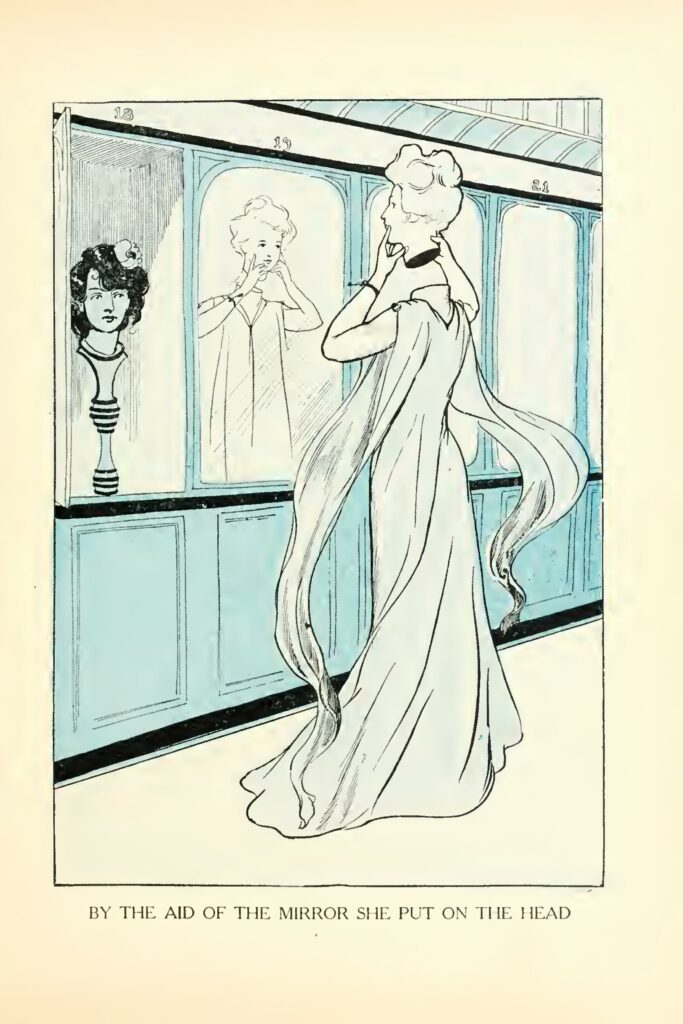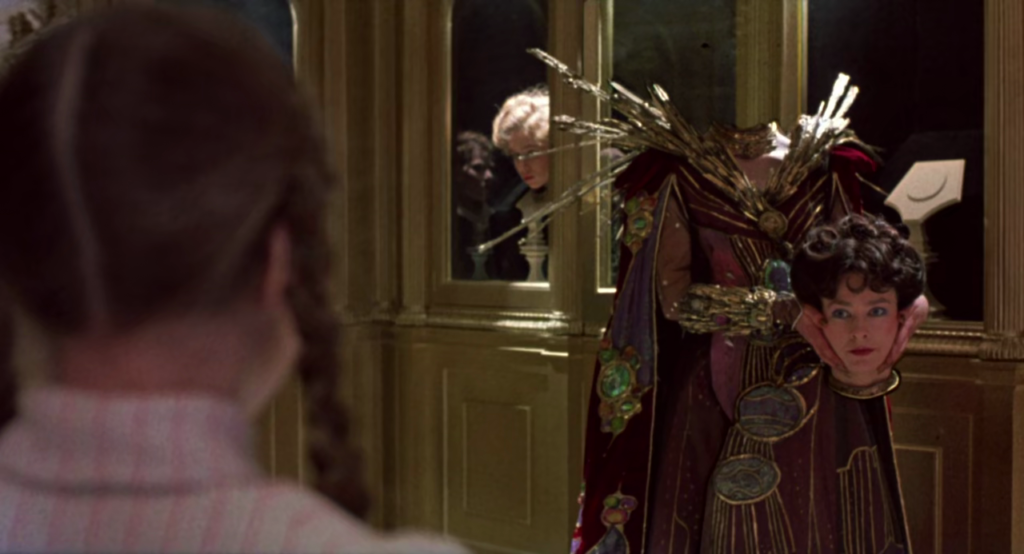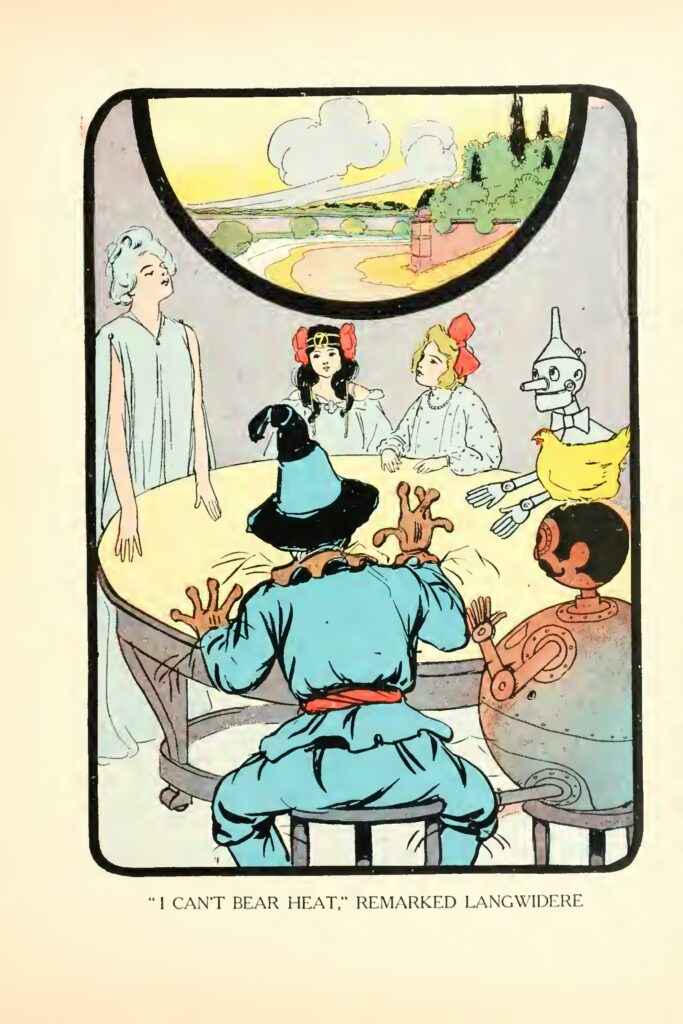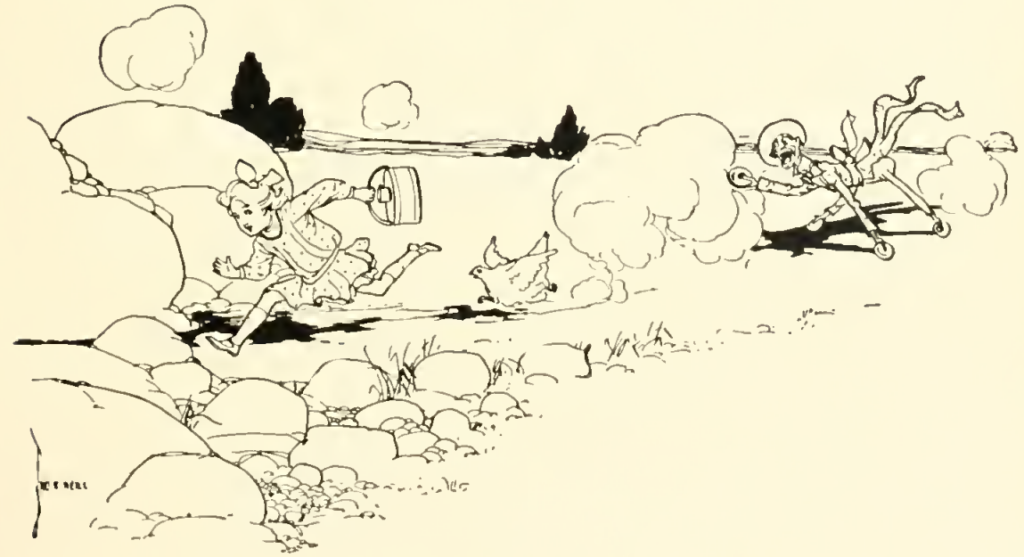Walter Murch and crew lifted most of the material for the (awesome) 1985 almost-horror movie Return to Oz from Ozma of Oz, also incorporating scenes and concepts from The Marvelous Land of Oz. The film’s premise of the Nome King attacking the Emerald City originates in the sixth Oz novel, The Emerald City of Oz. The Nomes in this film are literally stone, moving freely in the rocks throughout Oz, certainly a more striking visual than Neill’s illustrations and closer to Baum’s description. A few of the features Return to Oz takes from Ozma of Oz include Dorothy and Billina riding a chicken coop in a storm and washing up in a desert; the Wheelers and their threats over an allegedly stolen lunch pail; Dorothy escaping the Wheelers with a key to find a long deactivated Tiktok, who bears a plaque on his back that says “Thinks, Speaks, Acts, and Does Everything but Live” (55); Tiktok fighting the Wheelers with the lunch pail and taking one prisoner; the prisoner leading them to a princess of a desolate country; and the princess sitting around a hall of mirrors strumming a mandolin and changing her head instead of her clothes, keeping dozens of severed human heads in cabinets locked with a ruby key that she wears on her person. It’s disturbing. Of course, Return to Oz also features the Nome King, who, like in Ozma of Oz, puffs a pipe he lights with a hot coal while forcing Dorothy and her friends to play an unfair game to (in an abstract magical way) end their lives, one by one.

Baum’s version is both softer and darker, in different ways. In Return to Oz, for example, the head-swapping princess is named Mombi. She closely resembles Langwidere from Ozma of Oz but has a similar role to the Mombi of The Marvelous Land of Oz insofar as she hides Ozma away. In the end, all the women this version of Mombi beheaded are restored to life, while she is allowed to live but without her magic powers.

In Ozma of Oz, Langwidere is a “dangerous lady,” as the Scarecrow puts it (111), a surviving relative of Evoldo who has become a despot whose incompetence is matched only by her decadence. Like the film’s Mombi, Langwidere announces she will eat Billina and locks Dorothy in a tower, intending to keep her there until she can take her head for her collection.
However, Langwidere is too selfish and lazy to be a genuine threat to Dorothy. Langwidere immediately supports Ozma’s bid to free her relatives from the Nome King, “For if they were restored to their proper forms and station they could rule the Kingdom of Ev themselves, and that would save me a lot of worry and trouble. At present there are at least ten minutes every day that I must devote to affairs of state, and I would like to be able to spend my whole time in admiring my beautiful heads” (112). Baum does not directly address where Langwidere attains her dozens of heads. Considering that she tries to take Dorothy’s head, albeit in a trade, one would assume Langwidere has gathered them from large number of women and, apparently, children, a nightmarish idea with nightmarish implications. Unlike the film’s Mombi, this Langwidere faces no comeuppance. Her misdeeds are largely left to the reader’s imagination.

In contrast to Baum (perhaps) taking a darker approach, consider the Wheelers, a tribe of beings with wheels for hands and feet. The wheels are “of the same hard substance that our finger-nails and toe-nails are composed of” (44), pretty freaky. After Dorothy and Billina find an ominous message reading “BEWARE THE WHEELERS,” the Wheelers attack. Return to Oz faithfully depicts the Wheelers’ terrifying behavior: “Looking over her shoulder as she ran, the girl now saw a great procession of Wheelers emerging from the forest—dozens and dozens of them—all clad in splendid, tight-fitting garments and all rolling swiftly toward her and uttering their wild, strange cries” (46). The film even mirrors Dorothy’s dialogue with the Wheelers.

“We’ll get you in time, never fear! And when we do get you, we’ll tear you into little bits!”
“Why are you so cruel to me?” asked Dorothy. “I’m a stranger in your country, and have done you no harm” (47).
Dorothy’s reply is so innocent it is almost heartbreaking. I had assumed Return to Oz was being darker than the source material with these lines:
WHEELER: You have to come out sooner or later! And when you do, we’ll tear you into little pieces and throw you in the Deadly Desert!
DOROTHY: I haven’t done anything to you!
But no, it’s all there in the book.
